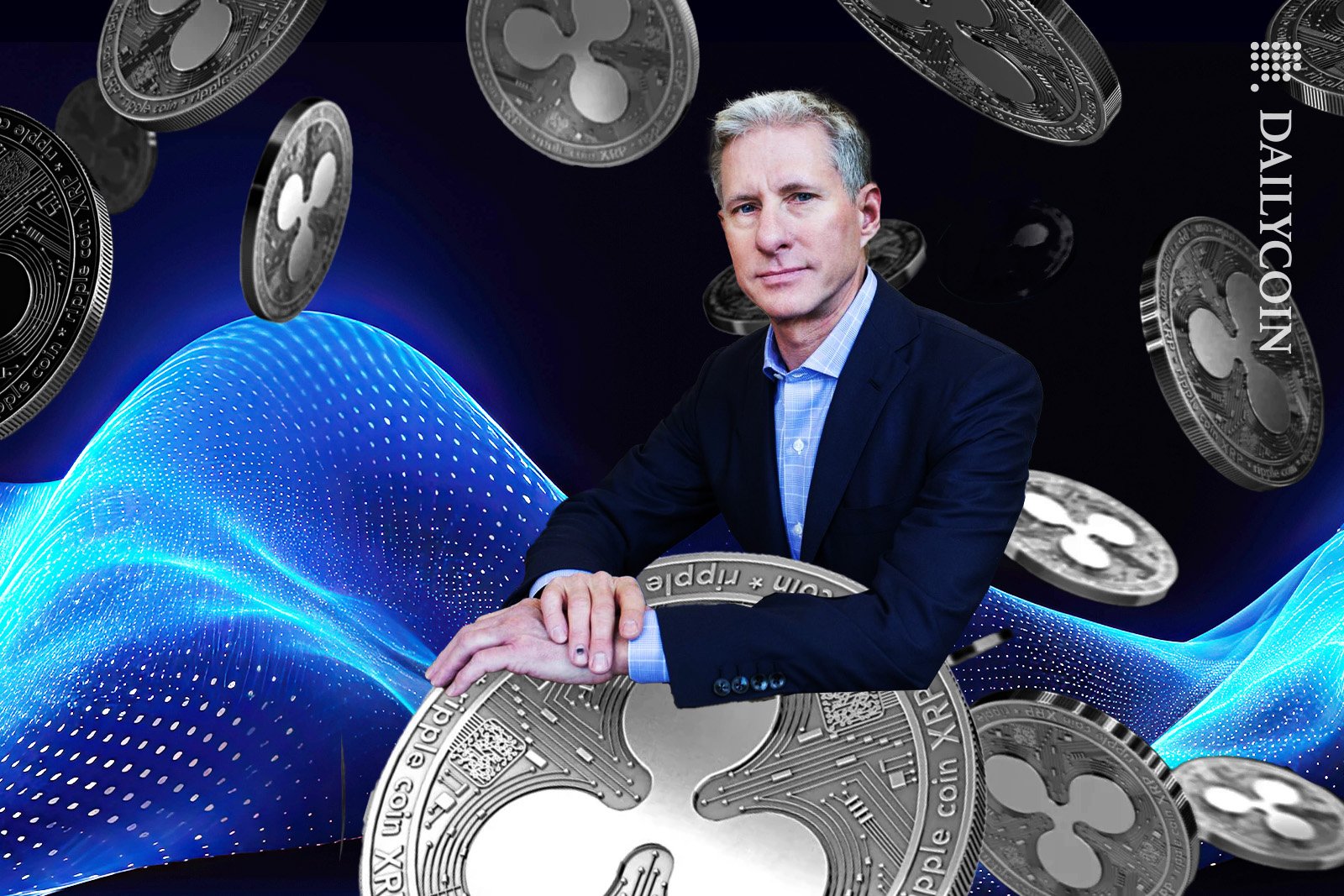
Alongside the polarizing Jed McCaleb and the mysterious Arthur Britto, Chris Larsen might be Ripple’s most reliable and consistent co-founder. While McCaleb parted ways with Ripple Labs shortly after the blockchain’s launch and Britto has never made a public appearance, Larsen always turns up for the XRP community.
Despite Brad Garlinghouse taking the reins as CEO, Chris Larsen has remained a key figure in the Ripple Labs team. As the company’s executive chairman, Larsen is responsible for much of the cryptocurrency project’s success.
Who is Chris Larsen, and how did this American entrepreneur go from conducting financial audits in Brazil and Indonesia to spearheading one of the largest platforms in the blockchain industry?
Table of Contents
Who Is Chris Larsen?

Chris Larsen is one of the co-founders of Ripple Labs, the fintech company behind Ripple (XRP) and the XRP Ledger. While he was originally the company’s CEO, Larsen brought on Brad Garlinghouse to expand and scale the blockchain company in 2016. Despite stepping back from the top position, Larsen is still heavily involved in Ripple Labs as Executive Chairman.
Sponsored
Beyond Ripple Labs, Chris Larsen has tasted plenty of success as an entrepreneur. Before diving into blockchain technology, Larsen launched a few successful startups within the fintech industry.
True to the spirit of cryptocurrency, financial accessibility and consumer advocacy are common themes throughout Larsen’s ventures. The Forbes List Angel Investor also boasts a somewhat generous philanthropic history, having donated to nonprofit charities in need.
Sponsored
But how did he get there?
Education
Born in the San Francisco Bay Area, California, in 1960, Larsen’s upbringing was far from what you might expect from a financial mogul. His mother worked as a freelance illustrator, while his father was an aircraft mechanic. It is hardly the background that might inspire someone to build a revolutionary cross-border payments platform that threatened to replace Bitcoin (BTC).
His academic path began at San Francisco State University, where he pursued a Bachelor of Science in international business and accounting. He graduated in 1984, wasting no time using his newfound knowledge.
Larsen spent several years working for the Chevron Corporation, a multinational company specializing in oil and gas. As part of Chevron’s financial team, Larsen conducted audits worldwide, working in exotic locations like Brazil and Indonesia.
Seeking to broaden his academic horizons, Chris Larsen returned to America full-time and enrolled at the Stanford Graduate School of Business, one of the world’s most prestigious institutions. Here, he earned his Master of Business Administration (MBA) in 1991, setting the stage for a range of financial startups over the coming years.
Early Career
With worldly experience and an MBA, Larsen worked to improve the world. He began in the real estate sector as a mortgage lender in Palo Alto, California. This early experience gave Larsen crucial insights into the property industry, inspiring the first of his entrepreneurial startups and initiatives.
E-Loan
Frustrated by the mortgage lending processes of the late 1990s, Larsen sought to streamline operations using the novel and revolutionary technology of the time: the internet. He saw the internet as the perfect platform for bypassing expensive agency fees and lengthy administration processes.
Following an initial investment of around $450,000 from family and friends, E-Loan was successfully launched in 1997. The website made it easier than ever for users to shop for loans directly, avoiding the extortionate fees charged by mortgage brokers and sales agents.
At the time, this direct-to-consumer model was a game-changer in the mortgage industry. It democratized access to financial services, empowering consumers with information and choices previously obscured by layers of intermediaries.
Under Larsen’s leadership, E-Loan became the first company to provide consumers free access to their FICO credit scores.
By 2004, E-Loan had cemented itself as a powerhouse in the online real estate industry. By then, the company had processed over $18.9B in property loans and was eventually sold to Banco Popular in 2005, netting Larsen millions after the company’s IPO.
Prosper Marketplace
Following his success with E-Loan, Chris Larsen continued his entrepreneurial journey by co-founding Prosper Marketplace in 2005. Prosper Marketplace represented a significant leap forward in the peer-to-peer (P2P) lending space, a relatively new concept at the time.
Building off his success in the property industry, Larsen designed an online marketplace where lenders and borrowers could determine loan rates using Dutch auction pricing systems. The platform quickly gained traction, securing a spot in Fast Company’s top 50 most innovative companies of the year in 2008.
One of the innovative aspects of Prosper Marketplace was its transparency. The platform provided detailed credit grades for borrowers, allowing lenders to make informed decisions. This level of transparency was a significant shift from the opacity that often characterized traditional lending.
Unfortunately for Larsen, Prosper Marketplace was in hot water with the SEC because loan regulations targeted banks instead of emerging fintech firms.
By the end of 2011, Larsen’s second startup had handled over $271M in peer-to-peer loans and received over $74M in further funding.
But by this time, Larsen was beginning to turn his attention to yet another emerging technology that promised to revolutionize financial inclusion. As he would soon discover, Larsen’s next project would be his most ambitious and impressive.
Chris Larsen and Ripple Labs

In 2012, Chris Larsen co-founded yet another fintech company, this time building off a new tech phenomenon called blockchain that had originally started with Bitcoin a few years earlier. Originally called OpenCoin, the platform facilitated peer-to-peer transactions between two parties in a trustless, decentralized system.
Larsen teamed up with Jed McCaleb and Arthur Britto to make the dream a reality; with blockchain wizard David Schwartz operating as the company’s CTO, the dream team dove into the development of what would eventually become the XRP Ledger and the Ripple payments system. The company was renamed from OpenCoin to Ripple in 2013.
What made Ripple special was its innovative consensus process, which was faster and more energy-efficient than the traditional proof-of-work systems used by other cryptocurrencies like Bitcoin. This approach positioned Ripple as a more sustainable and scalable network provider in the digital currency space.
By 2014, Ripple had become the second-largest cryptocurrency in the industry, trailing only the reigning monarch, Bitcoin. The platform went from strength to strength, eventually bringing on Brad Garlinghouse in 2016 to steer the vessel to even greater heights.
What’s Next for the Crypto Billionaire?
Now that Ripple has established itself as one of the largest cryptocurrencies in the world and Chris Larsen has secured billionaire status, what lies ahead?
Garlinghouse’s appointment meant that Larsen could step back from the limelight. While he plays a far less active role in Ripple Labs’ daily operations, Larsen still greatly influences the project’s development as Ripple’s Executive Chairman.
But that being said, we’ve seen this behavior before. Before co-founding Ripple Labs, Larsen had stepped back from CEO responsibilities in favor of the Executive Chairman role. Perhaps the cycle is set to repeat itself, with Larsen launching yet another pro-consumer platform focused on financial accessibility.
Larsen has also proved he has a charitable streak, having donated over $1M USD to COVID relief funds during the pandemic. Is it possible that we will see further philanthropic endeavors from Chris Larsen in the future?
On the Flipside
- While Chris Larsen is credited as one of the lead founders of Ripple Labs and the XRP cryptocurrency, one could argue that the platform’s success is mainly due to the underlying technology developed by Jed McCaleb and David Schwartz.
Why This Matters
Chris Larsen has played a key role in the success of Ripple. If you’re an XRP fan, understanding the founder’s professional experience and background will help you gain insight into some of the motivations behind the platform itself.
FAQs
Chris Larsen made money by launching and operating a series of highly successful entrepreneurial startups. These include online mortgage lender E-Loan, Prosper Marketplace, and Ripple Labs.
Brad Garlinghouse is the current CEO of Ripple Labs, although Chris Larsen held the position before Garlinghouse’s appointment in 2016.
XRP was created by Chris Larsen, Jed McCaleb, Arthur Britto, and David Schwartz.
